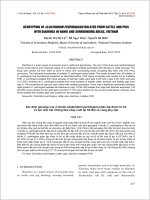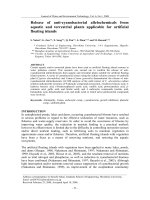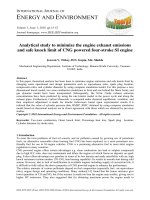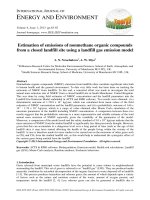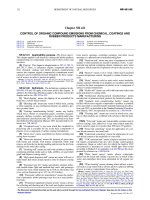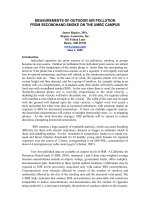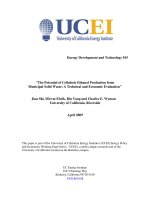- Trang chủ >>
- Khoa Học Tự Nhiên >>
- Vật lý
Dose dependence of room temperature photoluminescence from Si implanted SiO 2
Bạn đang xem bản rút gọn của tài liệu. Xem và tải ngay bản đầy đủ của tài liệu tại đây (98.44 KB, 4 trang )
Journal of Luminescence 80 (1999) 213—216
Dose dependence of room temperature photoluminescence
from Si implanted SiO
S. Cheylan*, N.B. Manson, R.G. Elliman
Research School of Physical Science and Engineering, Institute of Advanced Studies, Australian National University,
Canberra, ACT 0200, Australia
Abstract
Photoluminescence from Si implanted silica is studied as a function of Si fluence and Si concentration profile in order
to assess the effect of particle size and size distribution on emission spectra. Peaked (skewed Gaussian) concentration
profiles were produced by implanting with 400 keV Si ions and uniform Si profiles were produced by a multi-energy
implant sequences. Both as-implanted and annealed samples are shown to exhibit a distinct maximum in the emission
intensity as a function of ion fluence, with the intensity increasing with fluence up to the maximum and then decreasing at
higher fluences. Samples with a uniform Si profile are also shown to produce emission which is significantly red-shifted
relative to that of samples with a peaked Si profile. This is consistent with the fact that such samples are expected to have
a narrower particle size distribution (i.e. a greater fraction of larger particles). 1999 Elsevier Science B.V. All rights
reserved.
PACS: 73.61.Tm; 78.55.!m; 81.20.!n; 68.55.Ln
Keywords: Nanocrystal; Silica; Photoluminescence; Ion-implantation; Light emission; Photonics
1. Introduction
The optical properties of Si nanocrystals in SiO
have been studied extensively since visible room
temperature photoluminescence (PL) was first ob-
served in such systems [1]. However, despite in-
tense study, the physical origins of the PL remain
unclear. For example, it is still not known whether
the luminescence results from electronic transitions
within the nanocrystal itself or whether it results
from defect centres outside the nanocrystal [2—4].
* Corresponding author.
Further work is clearly required in order to fully
understand these processes.
Si nanocrystals are readily produced in SiO
by
ion-implantation and annealing. The excess Si, in-
troduced by ion implantation, forms small precipi-
tates during annealing. This is a relatively simple
process which is compatible with standard elec-
tronic and optoelectronic processing technologies.
It also has the advantage that it allows independent
control over the concentration and depth of the
implanted impurity, and the size of the nanocrys-
tals can be controlled by adjusting the implantation
(dose, temperature) and annealing (temperature,
time) parameters.
0022-2313/99/$ — see front matter 1999 Elsevier Science B.V. All rights reserved.
PII: S 0 0 2 2 - 2 3 1 3 ( 9 8 ) 0 0 1 0 0 - 8
Samples annealed at high temperature typically
exhibit a broad PL peak at around 750 nm, with an
increasing red shift with increasing implant dose
[4—6]. The interpretation of the emission spectra is
somewhat complicated by the fact that ion-im-
plantation also produces radiation damage in the
SiO
and by the fact that the resulting nanocrystals
have a broad size distribution. The latter is ex-
pected to result from the Gaussian concentration
profile produced by ion-implantation. It is there-
fore of interest to compare the PL emission from
samples implanted in a conventional manner with
that from samples containing nanocrystals with
a more uniform size distribution.
In this study, the PL emission is studied as
a function of implant dose and Si concentration
profile in order to assess the significance of nanoc-
rystal size and size distribution on the emission
spectrum. The effect of annealing ambient is also
briefly discussed.
2. Experimental
Fused silica plates, 1 mm thick, were implanted
with Si ions at room temperature. One set of sam-
ples was implanted with 400 keV Si ions to doses of
0.6, 1.0, 2.0, 3.0, 4.0 and 6.0;10
Si cm
\
, whilst
a second set was implanted with five successive
implants at energies of: 400, 300, 200, 150 and
100 keV to produce a uniform Si distribution over
the range 100—500 nm. In the latter case, implant
doses were chosen to give a uniform implant profile
with a concentration equal to the peak concentra-
tion of the four lowest dose single-energy implants.
According to calculations using the PROFILE
code, the single-energy implants give rise to
a peaked profile, as shown in Fig. 1a, and the
multiple energy implants give rise to a uniform
profile, as shown in Fig. 1b.
Implanted samples were subsequently annealed
to 1000°C for 1 h using a quartz tube furnace with
a flowing Ar ambient. Photoluminescence measure-
ments were performed at room temperature using
PROFILE is a commercially available code for calculating
high-dose implant profiles.
Fig. 1. Implant profiles calculated using the PROFILE code for
a single 400 keV implant to a dose of 3;10 Si cm\ (dotted)
and a multi-energy sequence designed to give approximately the
same peak concentration as the single-implant profile (solid).
the 488 nm line of an Ar ion laser as the excitation
source. The PL emission was collected by a quartz
light pipe and analysed using a grating spectrom-
eter (Digikrom model DK480) and a GaAs photo-
multiplier tube (Hamamatsu R943-02). Standard
lock-in detection techniques were used to improve
the signal-to-noise ratio and all spectra were cor-
rected for the system response.
3. Results and discussion
Fig. 2 shows typical PL emission spectra for
samples as-implanted with single-energy ions and
after annealing at 1000°C in Ar. As previously re-
ported [7—9], the spectra from as-implanted sam-
ples exhibit a single broad peak spread over the
range from 550 to 900 nm, centred at around
660 nm. This emission is believed to result prim-
arily from defect centres created in the SiO
by ion
implantation [10,11]. Interestingly, however, the
emission intensity is observed to increase with in-
creasing ion dose for doses up to 6;10
Si cm
\
and to decrease with increasing dose thereafter. The
initial increase is consistent with an increase in the
concentration of optically active defects, however,
the decrease at higher doses suggests that either the
nature of these defects is altered by subsequent
irradiation or that competing relaxation paths
214 S. Cheylan et al. / Journal of Luminescence 80 (1999) 213— 216
Fig. 2. PL emission spectra for samples: (a) as-implanted with
400 keV Si ions to various doses, and (b) after annealing to
1000°C in Ar for 1 h. Doses are indicated in the figure.
are created. (i.e. either the creation of non-radiative
defects or defects with emission wavelength outside
the region of observation.) This complex depend-
ence on ion dose is even more evident after
annealing, as shown by the spectra in Fig. 2b and
summarised in Fig. 3a. In this case, the emission
intensity exhibits a distinct maximum at a dose of
4;10
Si cm
\
compared to 6;10
Si cm
\
for
as-implanted samples. The strongest emission is
observed for a relatively narrow range of Si doses,
corresponding to peak Si concentrations around
2;10
Si cm
\
. The stronger emission after an-
nealing is consistent with previous reports and is
generally attributed to the annealing of defects in
SiO
[4—6]. However, preliminary results have
shown that the emission intensity can be increased
significantly by annealing at low temperatures
(500°C) in forming gas (H
/N
). This implies that
many alternative relaxation channels exist for excit-
ed carriers, even after high temperature annealing.
The reduced emission intensity at higher doses
Fig. 3. Emission intensity as a function of peak concentration
for samples with: (a) single-energy implants (peaked profiles) and
(b) multi-energy implants (uniform profiles). Circles indicate
as-implanted samples and diamonds represent samples annealed
at 1000°C in Ar.
could therefore result from a complex interplay
between different defects as a function of dose.
However, other possibilities also exist. For
example, interaction between Si nanocrystals is ex-
pected to increase with increasing Si concentration
(i.e. quantum tunnelling between crystallites, large
scale physical clustering). More work is clearly re-
quired in order to assess these possibilities.
PL emission spectra for samples as-implanted
with multi-energy Si ions are similar to those depic-
ted in Fig. 2a. However, after annealing, spectra
from these samples exhibit distinct differences from
those implanted with a peaked Si profile, as shown
in Fig. 3b and Fig. 4. First, the emission intensity is
much lower (approx. 30%) than that from samples
irradiated with a single-energy implant to the same
peak concentration, and second, the spectra exhibit
a significant red-shift relative to the single-implant
samples. Since the size distribution of precipitated
S. Cheylan et al. / Journal of Luminescence 80 (1999) 213— 216 215
Fig. 4. Peak emission wavelength as a function of total implant
dose for samples with: (a) single-energy implants (peaked pro-
files) and (b) multi-energy implants (uniform profile). Circles
indicate as-implanted samples and diamonds represent samples
annealed at 1000°C in Ar.
nanocrystallites is expected to be narrower (i.e.
greater fraction of larger particles) in the multi-
energy case it might be concluded that the domi-
nant emission comes from smaller particles and
that the emission is lower for samples with a uni-
form Si profile because of the reduced fraction of
smaller particles. However, if this were the case, the
emission intensity would be expected to increase for
lower concentration samples. As shown in Fig. 3b,
this is not the case. The lower emission intensity
must therefore relate to some other effect as well.
Interestingly, the emission intensity for samples im-
planted with multi-energy ions is enhanced 20 fold
by annealing in forming gas (H
/N
) at 500°C,
whereas only a factor of 7 is observed for single-
energy implants. After such an anneal the emission
intensity is therefore similar in both cases. This
again suggests that many defects survive high-tem-
perature annealing.
Fig. 4 compares the peak of the emission spec-
trum for single and multi-energy implants as a func-
tion of total ion dose. For as-implanted samples
a slight redshift is observed with increasing dose for
sampleswithbothpeakedanduniformSiprofiles.
This effect is more pronounced for annealed sam-
ples, where the nanocrystals are more fully de-
veloped. Significantly, the red-shift is greater for
samples implanted with a uniform Si profile. This is
consistent with the fact that such a profile should
result in a greater fraction of larger particles.
4. Conclusions
It has been shown that the PL emission intensity
of as-implanted samples increases with increasing
dose to a maximum value before decreasing at high-
er doses, and that such samples exhibit a monotonic
redshift with increasing dose. In addition, it has been
shown that Si nanocrystals precipitated within
a uniform Si distribution exhibit PL emission which
is red-shifted relative to nanocrystallites precipitated
within a peaked profile. This is consistent with the
expected narrowing of the nanocrystal size distribu-
tion in the uniform case. Measurements are in pro-
gress to correlate the measured nanocrystal size dis-
tribution and PL emission spectrum.
References
[1] L.T. Cahnam, Appl. Phys. Lett. 57 (1990) 1046.
[2] G. Qin, G.G. Qin, J. Appl. Phys. 82 (1997) 2572.
[3] S K. Ma, J.T. Lue, Thin Solid Films 304 (1997) 353.
[4] A.D. Lan, B.X. Liu, X.D. Bai, J. Appl. Phys. 82 (1997) 5142.
[5] T. Shimizu-Iwayama, K. Fujita, M. Akai, S. Nakao,
K. Saitoh, J. Non Cryst. Solids 187 (1995) 112.
[6] Y. Kanzawa, T. Kageyama, S. Takeoka, M. Fujii, S.
Hayashi, K. Yamamoto, Solid State Commun. 102 (1997)
533.
[7] S. Guha, M.D. Pace, D.N. Dunn, I.L. Singer, Appl. Phys.
Lett. 70 (1997) 1207.
[8] P. Mutti, G. Ghislotti, S. Bertoni, L. Bonoldi, G.F.
Cerofolini, L. Meda, E. Grilli, M. Guzzi, Appl. Phys. Lett.
66 (1995) 851.
[9] H.A. Atwater, K.V. Schcheglov, S.S. Wong, K.J. Vahala,
R.C. Flagan, M.L. Brongersma, A. Polman, Mater. Res.
Soc. Symp. Proc. 316 (1994) 409.
[10] T. Shimizu-Iwayama, K. Fujita, M. Akai, S. Nakao,
K. Saitoh, J. Appl. Phys. 75 (1994) 7779.
[11] H.Z. Song, X.M. Bao, Phys. Rev. B 55 (1997) 6988.
216 S. Cheylan et al. / Journal of Luminescence 80 (1999) 213— 216
